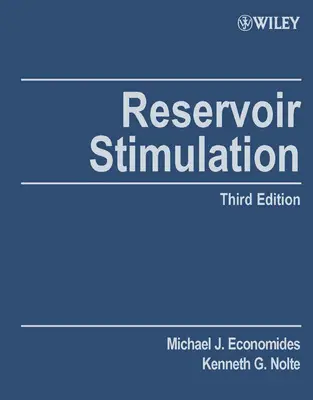"Reservoir Stimulation" ed. by Michael J. Economides, Kenneth G. Nolte
Thrid Edition
Sсhlumbеrgеr Dоwеll, John Wilеу & Sоns | 2000 | ISBN: 0471491926 9780471491927 | 824 pages | PDF | 11 MB
Thrid Edition
Sсhlumbеrgеr Dоwеll, John Wilеу & Sоns | 2000 | ISBN: 0471491926 9780471491927 | 824 pages | PDF | 11 MB
This extensive reference work remains essential reading for petroleum industry professionals involved in the important activities of reservoir evaluation, development and management, who require invaluable skills in the application of the techniques described for the successful exploitation of oil and gas reservoirs.
Contributors to this volume are among the most recognized authorities in their individual technologies. The editors are grateful for their participation and thank clients, academic institutions and other organizations for supporting the completion of this text.
This edition reflects the changing technologies in the industry and contains 20 chapters written by 44 authors. It provides an overview of reservoir stimulation from an all-encompassing engineering standpoint, an overview currently unavailable elsewhere.
Contents
Preface. Hydraulic Fracturing, A Technology For All Time
Chapter 1. Reservoir Stimulation in Petroleum Production
1-1. Introduction
1-2. Inflow performance
1-3. Alterations in the near-wellbore zone
1-4. Tubing performance and NODAL* analysis
1-5. Decision process for well stimulation
1-6. Reservoir engineering considerations for optimal production enhancement strategies
1-7. Stimulation execution
Chapter 2. Formation Characterization: Well and Reservoir Testing
2-1. Evolution of a technology
2-2. Pressure derivative in well test diagnosis
2-3. Parameter estimation from pressure transient data
2-4. Test interpretation methodology
2-5. Analysis with measurement of layer rate
2-6. Layered reservoir testing
2-7. Testing multilateral and multibranch wells
2-8. Permeability determination from a fracture injection test
Chapter 3. Formation Characterization: Rock Mechanics
3-1. Introduction
3-2. Basic concepts
3-3. Rock behavior
3-4. Rock mechanical property measurement
3-5. State of stress in the earth
3-6. In-situ stress measurement
Chapter 4. Formation Characterization: Well Logs
4-1. Introduction
4-2. Depth
4-3. Temperature
4-4. Properties related to the diffusion of fluids
4-5. Properties related to the deformation and fracturing of rock
4-6. Zoning
Chapter 5. Basics of Hydraulic Fracturing
5-1. Introduction
5-2. In-situ stress
5-3. Reservoir engineering
5-4. Rock and fluid mechanics
5-5. Treatment pump scheduling
5-6. Economics and operational considerations
Appendix: Evolution of Hydraulic Fracturing Design and Evaluation
Chapter 6. Mechanics of Hydraulic Fracturing
6-1. Introduction
6-2. History of early hydraulic fracture modeling
6-3. Three-dimensional and pseudo-three-dimensional models
6-4. Leakoff
6-5. Proppant placement
6-6. Heat transfer models
6-7. Fracture tip effects
6-8. Tortuosity and other near-well effects
6-9. Acid fracturing
6-10. Multilayer fracturing
6-11. Pump schedule generation
6-12. Pressure history matching
Chapter 7. Fracturing Fluid Chemistry and Proppants
7-1. Introduction
7-2. Water-base fluids
7-3. Oil-base fluids
7-4. Acid-based fluids
7-5. Multiphase fluids
7-6. Additives
7-7. Proppants
7-8. Execution
Acknowledgments
Chapter 8. Performance of Fracturing Materials
8-1. Introduction
8-2. Fracturing fluid characterization
8-3. Characterization basics
8-4. Translation of field conditions to a laboratory environment
8-5. Molecular characterization of gelling agents
8-6. Rheology
8-7. Proppant effects
8-8. Fluid loss
Chapter 9. Fracture Evaluation Using Pressure Diagnostics
9-1. Introduction
9-2. Background
9-3. Fundamental principles of hydraulic fracturing
94. Pressure during pumping
9-5. Analysis during fracture closure
9-6. Pressure interpretation after fracture closure
9-7. Numerical simulation of pressure: combined analysis of pumping and closing
9-8. Comprehensive calibration test sequence
Appendix: Background for hydraulic fracturing pressure analysis techniques
Chapter 10. Fracture Treatment Design
10-1. Introduction
10-2. Design considerations
10-3. Geometry modeling
10-4. Treatment schedule
10-5. Multilayer fracturing
10-6. Acid fracturing
10-7. Deviated wellbore fracturing
Chapter 11. Fracturing Operations
11-1. Introduction
11-2. Completions
Appendix: Understanding perforator penetration and flow performance
Chapter 12. Post-Treatment Evaluation and Fractured Well Performance
12-1. Introduction
12-2. Post-treatment fracture evaluation
12-3. Factors affecting fractured well performance
12-4. Well test analysis of vertically fractured wells
12-5. Prediction of fractured well performance
Chapter 13. Introduction to Matrix Treatments
13-1. Introduction
13-2. Candidate selection
13-3. Formation damage characterization
13-4. Stimulation technique determination
13-5. Treatment design
13-6. Final economic evaluation
13-7. Execution
13-8. Treatment evaluation
Chapter 14. Formation Damage: Origin, Diagnosis and Treatment Strategy
14-1. Introduction
14-2. Damage characterization
14-3. Formation damage descriptions
14-4. Origins of formation damage
14-5. Laboratory identification and treatment selection
14-6. Treatment strategies and concerns
14-7. Conclusions
Chapter 15. Additives in Acidizing Fluids
15-1. Introduction
15-2. Corrosion inhibitors
15-3. Surfactants
15-4. Clay stabilizers
15-5. Mutual solvents
15-6. Iron control additives
15-7. Alcohols
15-8. Acetic acid
15-9. Organic dispersants
15-10. Organic solvents
15-11. Diversion
15-12. Additive compatibility
15-13. Facility upsets following acid stimulation
Chapter 16. Fundamentals of Acid Stimulation
16-1. Introduction
16-2. Acid-mineral interactions
16-3. Sandstone acidizing
16-4. Carbonate acidizing
Appendix: Advances in understanding and predicting wormhole formation
Chapter 17. Carbonate Acidizing Design
17-1. Introduction
17-2. Rock and damage characteristics in carbonate formations
17-3. Carbonate acidizing with hydrochloric acid
17-4. Other formulations
17-5. Treatment design
17-6. Conclusions
Acknowledgments
Chapter 18. Sandstone Acidizing
18-1. Introduction
18-2. Treating fluids
18-3. Solubility of by-products
18-4. Kinetics: factors affecting reaction rates
18-5. Hydrofluoric acid reaction modeling
18-6. Other acidizing formulations
18-7. Damage removal mechanisms
18-8. Methods of controlling precipitates
18-9. Acid treatment design considerations
18-10. Matrix acidizing design guidelines
18-11. Acid treatment evaluation
18-12. Conclusions
Chapter 19. Fluid Placement and Pumping Strategy
19-1. Introduction
19-2. Choice of pumping strategy
19-3. Chemical diverter techniques
19-4. Foam diversion
19-5. Ball sealers
19-6. Mechanical tools
19-7. Horizontal wells
19-8. Conclusions
Acknowledgments
Chapter 20. Matrix Stimulation Treatment Evaluation
20-1. Introduction
20-2. Derivation of bottomhole parameters from wellhead measurements
20-3. Monitoring skin effect evolution during treatment
20-4. Prouvost and Economides method
20-5. Behenna method
20-6. Inverse injectivity diagnostic plot
20-7. Limitations of matrix treatment evaluation techniques
20-8. Treatment response diagnosis
20-9. Post-treatment evaluation
20-10. Conclusions
References
Nomenclature
with TOC BookMarkLinks



